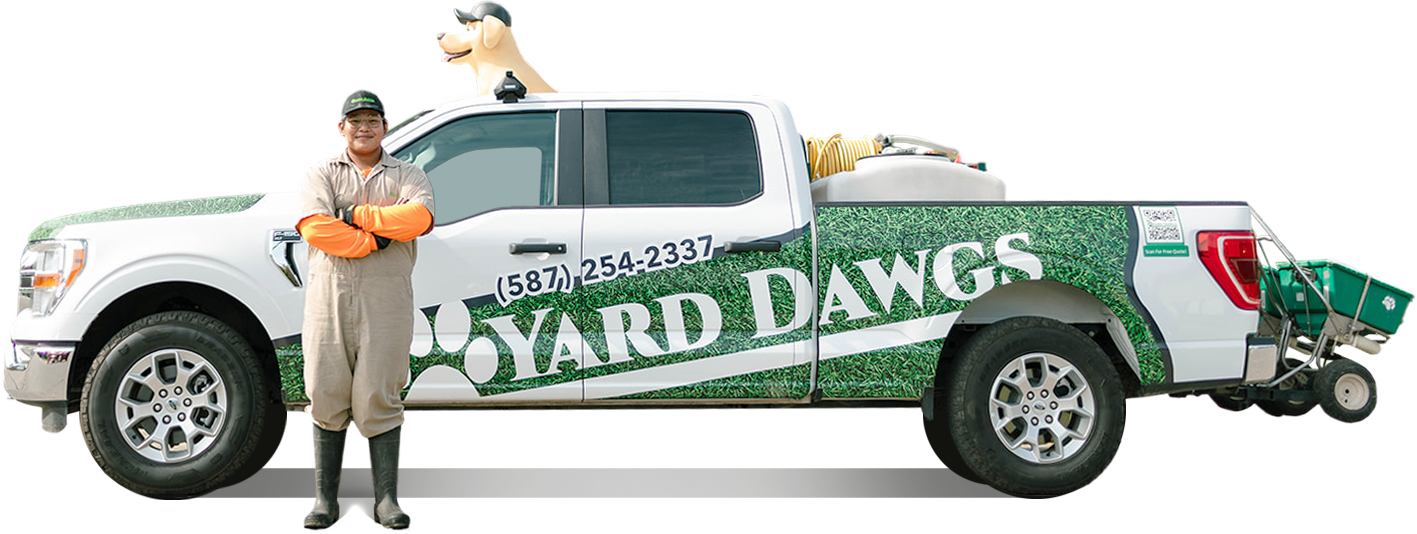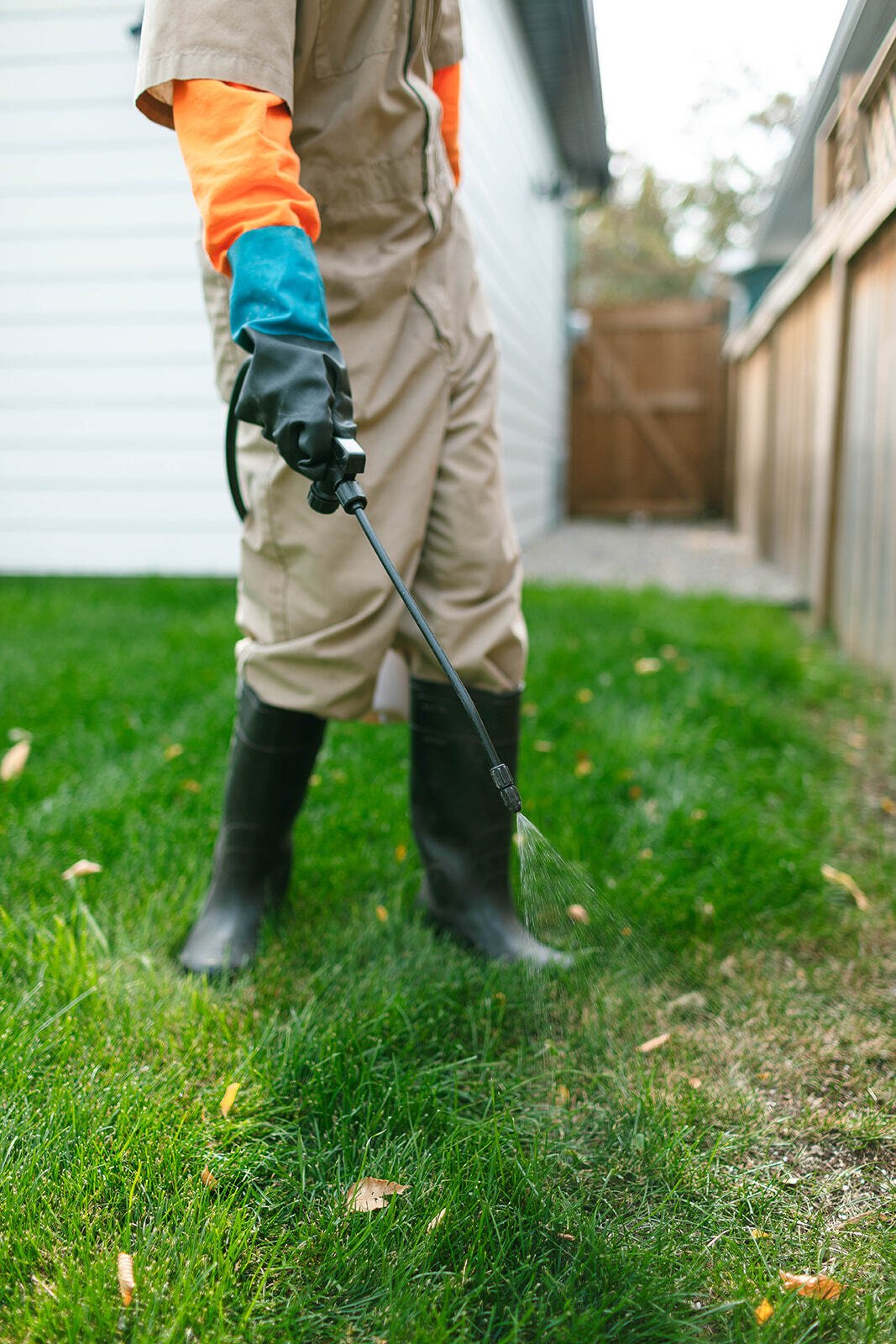What Is Aeration
Aeration is the process of taking cores of soil out of your lawn to make room for air, nutrients, and water to penetrate the ground. The cores are left on top of the grass to decompose and recycle the nutrients back into the earth. The benefit to lawn aeration is grass that is healthy, thick, and robust and able to handle the harshness of a Canadian winter. It stimulates new growth and increases the impact of fertilization.

Alberta has compact, clay-based soil and aeration is, therefore, an especially important provision for Alberta lawns. Foot traffic, children’s play vehicles, lawn mowers and other equipment on top of the lawn will contribute to compaction.
The Government of Alberta published “practical information” for Alberta’s Agriculture Industry on the effects of soil compaction. Granted, this is addressing crop production concerns, but the effects of compaction are the same for both a residential lawn and a farmer’s field.
-
Causes soil pore spaces to become smaller
-
Reduces water infiltration rate into soil
-
Decreases the rate that water will penetrate into the soil root zone and subsoil
-
Increases the potential for surface water ponding, water runoff, surface soil waterlogging and soil erosion
-
Reduces the ability of a soil to hold water and air, which are necessary for plant root growth and function
-
Limits soil exploration by roots and decreases the ability of crops to take up nutrients and water efficiently from soil
Most soils are composed of 50% solids (silt, sand, and clay) and about 50% pore spaces. So, evidently compaction can be a pretty serious problem for a homeowner.
What Does Aerating Lawn Do?
Aerating your lawn has multiple benefits that contribute to its overall health and vitality. It allows better air circulation, which helps roots to access oxygen and promotes deeper growth. When soil is aerated, it becomes less compact, allowing water to seep deeper into the ground rather than running off the surface. This means your grass can access the moisture it needs more effectively, leading to stronger, healthier roots. In addition, nutrients from fertilizers can be absorbed more efficiently, encouraging lush growth and improving your lawn’s ability to resist diseases and pests. Simply put, aerating your lawn gives your grass the best chance to thrive.
Why Aerate Your Lawn
Aerating Lawn Encourages Stronger Grass Growth
Aerating your lawn provides essential benefits for the overall health of your grass. By allowing air, water, and nutrients to reach the roots more easily, it strengthens the root system and encourages thicker, healthier grass. Healthy grass grows more vigorously and is better able to withstand environmental stresses like extreme weather, pests, and diseases. With improved root development, your grass will be more resilient and able to thrive throughout the year.
Aerating Lawn Eases Soil Compaction
The most minute of activities; children playing on the grass, a lawn mower being pushed across the yard, active pets, these all will lead to a compacted soil. Compacted soil in your lawn will impede root growth and leads to the accumulation of thatch. This would be a layer of organic material composed of dead plant matter, decomposing grass and leaves, and debris that collects at the soil’s surface. Although thatch can be beneficial, when it becomes too thick it can begin to choke out the grass in your lawn. Additionally, chinch bugs overwinter in the thatch layer of your grass. These are devastating lawn pests, and therefore should not find a favourable environment in your lawn. Aeration relieves this compaction by removing small plugs of soil, creating more room for air and water to reach the roots. This improved soil structure helps reduce water runoff and allows deeper root penetration, which leads to healthier, more robust grass.
Aerating Lawn Helps Manage Thatch Buildup
Thatch is the layer of organic material, including dead grass, leaves, and other debris, that accumulates on the surface of your lawn. While a thin layer of thatch can provide benefits, such as acting as a natural mulch and protecting the soil, excessive thatch can suffocate your grass and limit its growth. Aeration helps break up the thatch layer, allowing nutrients, water, and air to penetrate the soil more effectively. By reducing excessive thatch, aeration ensures that your grass has the space and resources it needs to grow strong.
Aerating Lawn Stimulates Fresh Growth
Aeration stimulates new growth by creating the ideal environment for roots to spread and absorb nutrients. When the soil is loosened through aeration, it provides space for new root development, allowing your lawn to fill in with fresh grass. This is especially important during the growing season, as aeration supports the grass's ability to recover from stress, such as drought, foot traffic, or damage from pests. Aeration is a key component of rejuvenating a lawn and giving it the best chance to grow thick, healthy, and lush.
When To Aerate Your Lawn
In Canada, the lawn of your home is composed of cool season grass. Which is why your grass is able to bounce back after dormancy during the winter months. Warm season grasses put their energy into summer growth while cool season grasses grow most in the spring and the fall. This means your lawn is increasing its root zones in the fall to prepare for the winter months. The roots of grass can grow at soil temperatures below 10C. Growth is drastically reduced in the winter months when temperatures are below freezing.
In an article released by Penn State University, “Since the rooting depth of cool-season grasses is usually between 2 and 6 inches, most water absorption initially occurs near the soil surface. As the surface water is depleted, roots begin using up water deeper in the soil… Contrary to popular belief, roots do not ‘seek out’ water, instead they grow more vigorously and proliferate where water is available.”
This article outlines the need for water access within the soil of turf grasses. If you want deep roots, water needs to penetrate below the surface. This article also details the need turf grasses have for an adequate supply of oxygen for normal growth and development. “Severely compacted soils have limited supplies of oxygen and will not support good root growth even when favorable temperatures and moisture levels are present.” So, when snow covers the ground after you have aerated in the fall, you’ve opened your lawn up to the water that will melt into the surface.
Aerating in the fall reduces the need for de-thatching or power raking. This is because of how detrimental power raking is for your lawn. The crown of your grass is the whitish part of the bottom of the blade, and it is the ‘mothership’ of the grass.
Thatch is the layer of grass growing between the crown of your grass and the soil of your lawn. To access the thatch, your power rake must go through the crown. If the roots are killed or the blades die, the grass can resurrect. If the crown of the grass is destroyed, which happens during the power raking, your grass will not survive. It will be dead for good. Therefore, it’s important to avoid the need for power raking in the spring.
.png?width=725&name=Test%20Your%20Aeration%20Knowledge%20(2).png)
Additionally, thatch can be beneficial to your lawn. It is a natural weed barrier because weeds have a hard time growing through the layer of dead grass. It also limits the damage of foot traffic on your lawn. However, too much thatch will choke out your lawn.
Why Not Aerate In The Spring?
It’s April, you can see your lawn, the birds have returned, and you’ve decided to open your lawn to water and nutrients through aeration. A couple weeks later you notice weeds starting to emerge and a week after that they’ve started taking over your lawn. Why is that? You’ve probably established the reason why. In the spring, when weeds are germinating, you’re opening the soil to them, basically welcoming them into your lawn.
The Center for Agriculture, Food, and the Environment at the University of Massachusetts describes summer annuals as follows:
Summer annual weeds generally emerge as soon as soil temperatures warm in the spring or early summer. Many species continue to germinate throughout the summer under adequate conditions. Summer annual weeds grow, flower, produce seed and are killed by frost during the fall season. Summer annual weeds are often difficult to manage, as many species are better suited to summer conditions than desirable cool season turfgrass species. Examples are crabgrass, knotweed, and prostrate spurge.
So, if you choose to aerate in the spring, you’re welcoming summer annual weeds into your grass. Instead, aeration in the fall sets up your lawn for continued growth when spring comes around. After the winter months, weeds will have a much harder time germinating in healthy and thick grass. So, both aeration and fertilization are essential between September and October.
Now we hear homeowners argue “my local golf course aerates a couple times a year!” My question to those people is this: do you have golf carts passing back and forth over your lawn? Only heavily used turf requires aeration more than once a year. This is because the benefits of reducing compaction outweigh the possibility of weed emergence in the spring.
Aerating A Lawn Before And After
Allowing air, nutrients, and water to penetrate the soil will do more for a lawn than many people realize. In combination with other lawn treatments, it will completely transform the grass.
.png?width=729&name=Simple%20Before%20and%20After%20LUT%20Slider%20Post%20Facebook%20Post%20(1).png)
Aeration Summary
The takeaway is this: there are many lawn care services that you should be performing on your lawn each season; you just need to be sure it's the right time of the year. You wouldn't go out to shovel snow in August (well maybe if you live in Alberta), just as you shouldn't aerate your lawn in the spring. Lawn aeration is a beneficial and crucial part of your lawn care regime, that should not be confused with deciding not to do it annually. We want your lawn to be the absolute best on the block, and that means giving you the right tools for lawn care success. You deserve a thick, lush and green lawn!


















